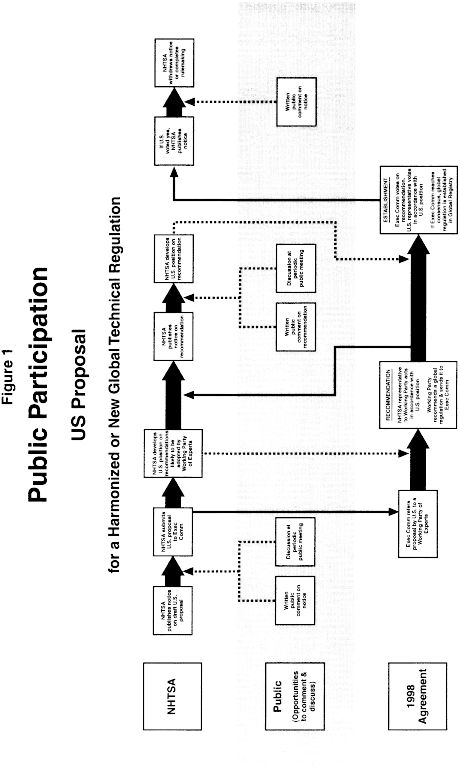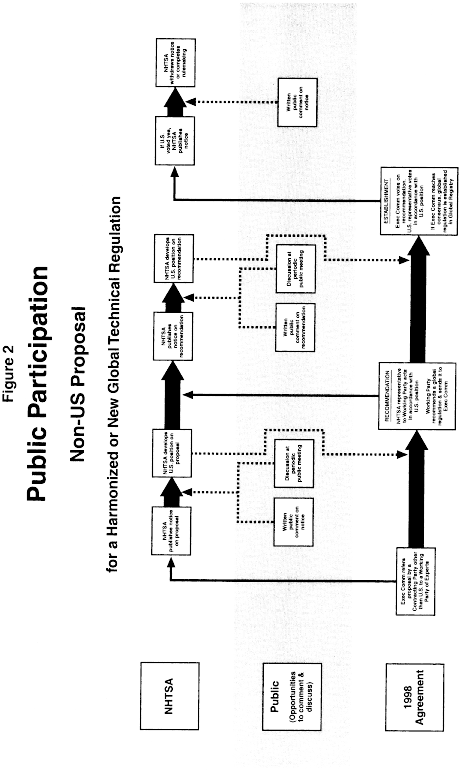Appendix C to Part 553 - Statement of Policy: Implementation of the United Nations/Economic Commission for Europe (UN/ECE) 1998 Agreement on Global Technical Regulations - Agency Policy Goals and Public Participation
49:6.1.2.3.25.4.7.1.24 : Appendix C
Appendix C to Part 553 - Statement of Policy: Implementation of the
United Nations/Economic Commission for Europe (UN/ECE) 1998
Agreement on Global Technical Regulations - Agency Policy Goals and
Public Participation I. Agency Policy Goals for the 1998 Global
Agreement and International Motor Vehicle Safety Harmonization A.
Paramount Policy Goal Under the 1998 Global Agreement
Continuously improve safety and seek high levels of safety,
particularly by developing and adopting new global technical
regulations reflecting consideration of current and anticipated
technology and safety problems.
B. Other Policy Goals
1. Adopt and maintain U.S. standards that fully meet the need in
the U.S. for vehicle safety.
2. Harmonize U.S. standards with those of other countries or
regions, particularly by raising U.S. standards at least to the
level of the best practices in those other safety standards.
3. Enhance regulatory effectiveness through regulatory
cooperation with other countries and regions, thereby providing
greater safety protection with available government resources.
II. Public Participation and the Establishing of Global Technical
Regulations for Motor Vehicle Safety, Theft, and Energy Efficiency
A. Summary of the Process Under the 1998 Global Agreement for
Establishing Global Technical Regulations 1. Proposal Stage
A Contracting Party submits a proposal for either a harmonized
or new global technical regulation to the Executive Committee of
the 1998 Global Agreement (i.e., the Contracting Parties to
the Agreement). If appropriate, the Committee then refers the
proposal to a working party of experts to develop the technical
elements of the regulation.
2. Recommendation Stage
When a working party of experts recommends a harmonized or new
global technical regulation, it sends a report and the recommended
regulation to the Executive Committee. The Committee then
determines whether the recommendations are adequate and considers
the establishment of the recommended regulation.
3. Establishment Stage
If the Executive Committee reaches consensus in favor of that
recommended global technical regulation, the global technical
regulation is established in the Global Registry.
B. Notice of Annual Work Program of WP.29
Each year, NHTSA will publish a notice concerning the motor
vehicle safety, theft, and energy efficiency aspects of the annual
program of work for the UN/ECE's World Forum for Harmonization of
Vehicle Regulations (WP.29). Each notice will include:
1. A calendar of scheduled meetings of WP.29 participants and
working parties of experts, and meetings of the Executive
Committee; and
2. A list of the global technical regulations that:
a. Have been proposed and referred to a working party of
experts, or
b. Have been recommended by a working party of experts.
Periodically, the notice will also include a request for public
comments on the subjects for which global technical regulations
should be established under the 1998 Global Agreement. The agency
will publish a subsequent notice identifying the priorities on
which NHTSA will focus in the future under the 1998 Global
Agreement. C. Public Meetings
NHTSA will hold periodic public meetings on its activities under
the 1998 Global Agreement. If the extent of recent and anticipated
significant developments concerning those activities so warrant,
NHTSA will hold a public meeting within the 60-day period before
each of the three sessions of WP.29 held annually. At each of these
public meetings, NHTSA will:
1. Brief the public on the significant developments that
occurred at the session of WP.29, the meetings of the working
parties of experts and the meetings of the Executive Committee
since the previous public meeting;
2. Based on the availability of provisional agendas, inform the
public about the significant issues to be addressed at upcoming
session of WP.29 and meetings of the working parties of experts and
any votes scheduled at the next session of the Executive Committee
on recommended global technical regulations; and
3. Invite public comment and questions concerning those past
developments and upcoming issues and votes and the general
positions that the U.S. could take regarding those votes, and
concerning any other significant developments and upcoming matters
relating to pending proposed or recommended global technical
regulations.
Appropriate agency officials will participate in the public
meetings. These public meetings may be held separately from or in
conjunction with the agency's quarterly meetings on its vehicle
rulemaking and research and development programs. The agency may
hold additional public meetings. D. Notices Concerning Individual
Global Technical Regulations 1. Notice Requesting Written Comment
on Proposed Global Technical Regulations
a. Proposals by the U.S. (See Figure 1.)
Before submitting a draft U.S. proposal for a global technical
regulation to WP.29, NHTSA will publish a notice requesting public
comments on the draft proposed global technical regulation. In the
case of a draft proposal for a harmonized global technical
regulation, the notice will compare that regulation with any
existing, comparable U.S. standard, including the relative impacts
of the regulation and standard. In the case of a draft proposal for
a new global technical regulation, the notice will generally
discuss the problem addressed by the proposal, the rationale for
the proposed approach for addressing the problem, and the impacts
of the proposal. NHTSA will consider the public comments and, as it
deems appropriate, revise the proposal and any of its supporting
documentation and then submit the proposal to WP.29.
b. Proposals by a Contracting Party other than the U.S.
(See Figure 2.)
After a proposal by a Contracting Party other than the U.S. has
been referred to a working party of experts and has been made
available in English by WP.29, NHTSA will make the draft proposal
available in the DOT docket (http://dms.dot.gov/). The
agency will then publish a notice requesting public comment on the
draft proposal and will consider the comments in developing a U.S.
position on the proposal.
2. Notice Requesting Written Comment on Recommended Global
Technical Regulations
If a working party of experts recommends a global technical
regulation and sends a report and the recommended regulation to the
Executive Committee, NHTSA will make an English language version of
the report and the regulation available in the DOT docket
(http://dms.dot.gov/) after they are made available by
WP.29. The agency will publish a notice requesting public comment
on the report and regulation. Before participating in a vote of the
Executive Committee regarding the establishment of the regulation,
the agency will consider the comments and develop a U.S. position
on the recommended technical regulation.
3. Notice Requesting Written Comment on Established Global
Technical Regulations
If a global technical regulation is established in the Global
Registry by a consensus vote of the Executive Committee, and if the
U.S. voted for establishment, NHTSA will publish a notice
requesting public comment on adopting the regulation as a U.S.
standard. Any decision by NHTSA whether to issue a final rule
adopting the regulation or to issue a notice terminating
consideration of that regulation will be made in accordance with
applicable U.S. law and only after careful consideration and
analysis of public comments.
E. Availability of Documents
As we obtain English versions of key documents relating to motor
vehicle safety, theft or energy conservation that are generated
under the 1998 Agreement (e.g., proposals referred to a working
party of experts, and reports and recommendations issued by a
working party), we will place them in the internet-accessible DOT
docket (http://dms.dot.gov/). Within the limits of available
resources, we will also place the documents on an international
activities page that will be included in our Website
(http://www.nhtsa.dot.gov/cars/rules/international/index.html).


[65 FR 51245, Aug.
23, 2000]